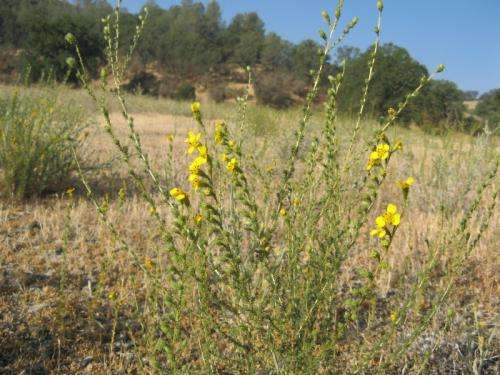How flower density impacts bee visits

(Phys.org) —Ever wonder how the density of flowers in a patch influences the kinds of insects that visit it? Carla Essenberg, a former graduate student in the Department of Biology at the University of California, Riverside, did, and proceeded to develop a mathematical "foraging model" that explores how flower visitors with diverse characteristics distribute themselves across flower patches differing from each other in floral density.
The model, which Essenberg developed at UC Riverside, predicts that, compared to competitors, species that fly from flower to flower in a patch at low speeds and that expend little time and energy in handling flowers to extract rewards will usually be found in denser flower patches.
"Because only some insects will be good pollinators, knowing which species will visit can help us predict how well plants will be pollinated," said Essenberg, now a postdoctoral research associate at the Center for Insect Science at the University of Arizona. "Understanding the effects of flower density on pollination can help prevent plant extinctions and perhaps help gardeners and farmers identify the optimal density for planting crops."
Study results appear in this month's issue of The American Naturalist.

Essenberg used her model to predict distributions of several bee species across sparse and dense patches of yellowflower tarweed, a wildflower found in grasslands throughout central California. She compared the predictions with observed changes in the species composition of flower visitors across yellowflower tarweed patches of increasing floral density. She found the model predictions compared favorably with observations: visitation by honeybees was highest in the densest flower patches whereas flowers in sparse and intermediate-density patches received more visits from long-horned bees, as predicted.
"Honeybees fly more slowly between flowers than long-horned bees do, and that makes them more likely to populate dense patches," Essenberg explained. "They're also larger, which means flying takes more energy. Again, that makes them more likely to exploit dense patches. Of course, other factors, particularly honeybees' unusual ability to communicate locations of food resources, could also be influencing what I saw. In the future, I would like to incorporate communication between colony members into the model."
More information: www.jstor.org/stable/10.1086/669157
Journal information: American Naturalist
Provided by University of California - Riverside



















